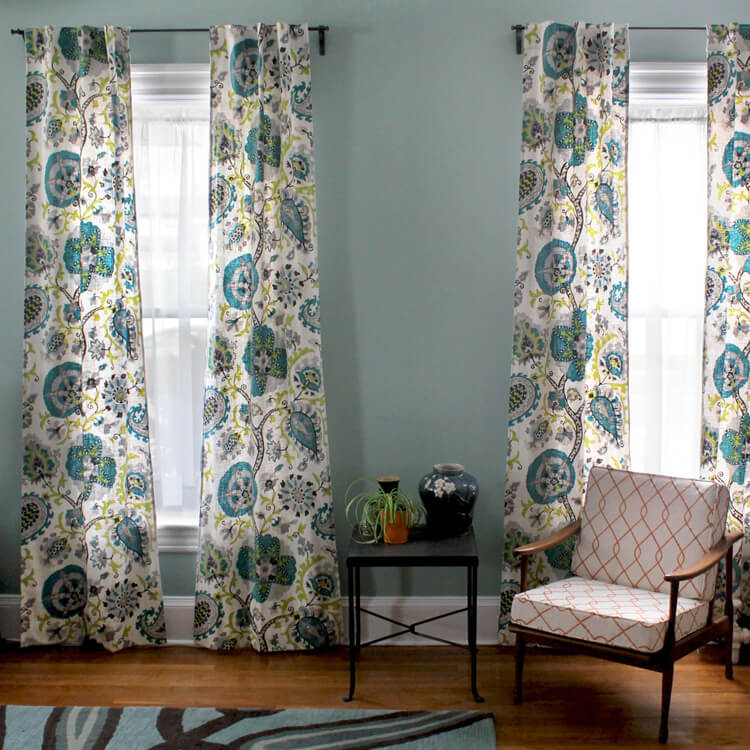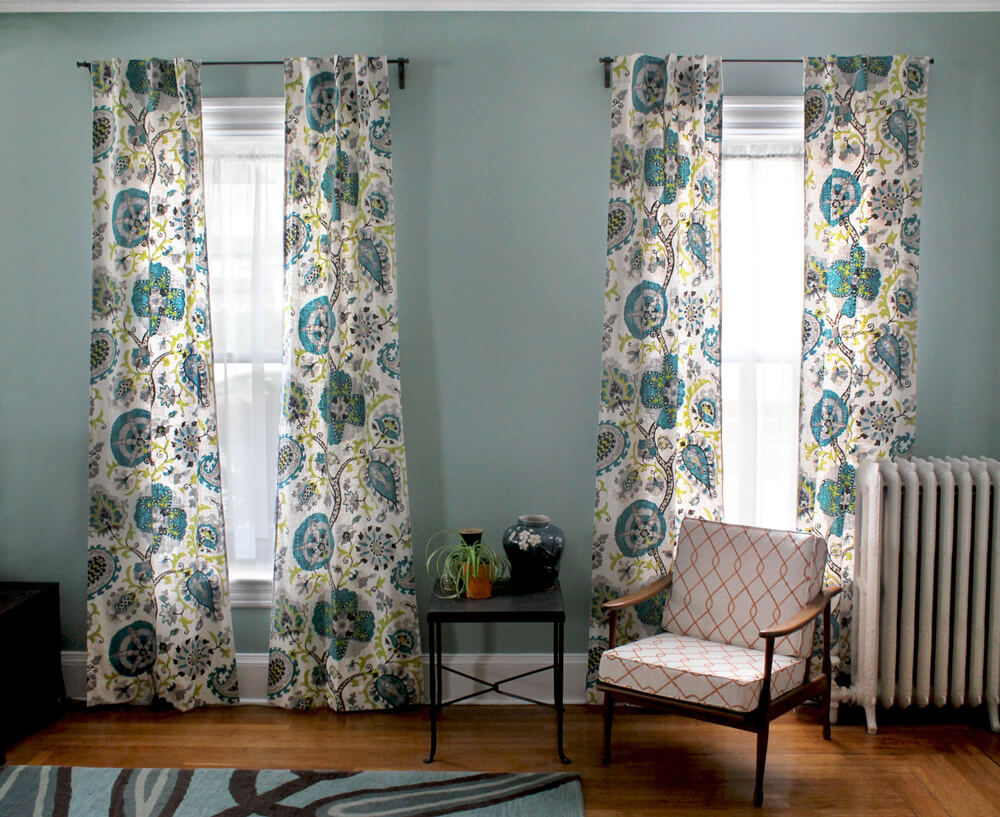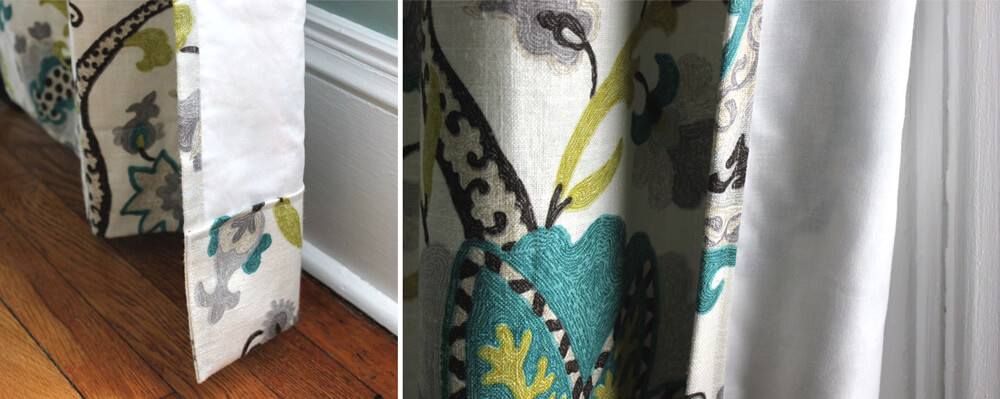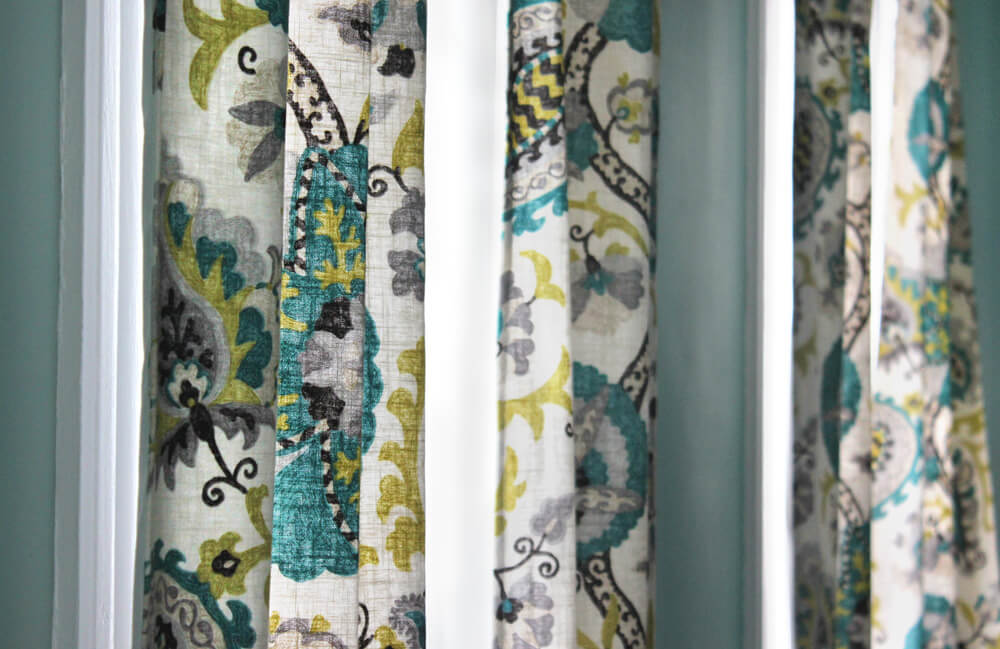Why use drapery lining?
When making back tab curtains for my living room, I wasn’t sure if I wanted to use a drapery lining or not. And if so, there are so many choices, which one do I pick?
At first, I was a little hesitant about using a lining because my living room is north-facing and can be a little dark. I still wanted light to come through even when the curtains are closed. Drapery linings can range from lightly filtering light to blocking it out completely. Plus they do so much more than just blocking light! Drapery Lining is used to line curtains for many different reasons, both aesthetic and practical.
Aesthetics
Drapery lining makes curtains drape better because it adds weight and body and can create full, well-defined pleats. It also gives curtains a polished, professional look.
Protection from sun and moisture
A drapery lining fabric helps protect your curtains from sun and moisture damage, increasing the life of your curtains. The sun can fade and damage fabric over time, so a lining provides a protective layer from harmful UV light, not only for the face fabric, but also for your furnishings. Blackout lining provides the most protection from the sun.
Water repellent and resistant drapery lining is designed specifically to protect the face fabric from moisture. Condensation on the window or rain from a forgotten open window can stain and damage your fabric. Water-repellant drapery lining shields your curtains from unwanted moisture. Many water-resistant linings are also stain and mildew resistant. They are a good choice for kitchens and bathrooms.
 L to R: Hanes White Weather Guard Drapery Lining, Roclon Rain No Stain Ivory Drapery Lining, Roclon Econosheen White Drapery Lining
L to R: Hanes White Weather Guard Drapery Lining, Roclon Rain No Stain Ivory Drapery Lining, Roclon Econosheen White Drapery Lining
Black Out Light
A common reason to use drapery lining is to block light. Blackout drapery lining is specifically designed to block most or all light. Does the morning light wake you up too early? Do you work late shifts and have to sleep during the day? Blackout lining is the way to go!
Blackout lining is made by taking a base fabric and first spraying it with a white acrylic foam. Then it’s sprayed with a black opaque membrane and finally another coat of white. This is referred to as 3 pass lining. There is also 2 pass, which skips the first coat. Both block the same amount of light, but the 3 pass has finished surfaces on both sides. If you’re using drapery lining alone or in an application where both sides are visible, go with the 3 pass.
 L to R: Roclon Budget Blackout Ivory/Ecru Drapery Lining, Hanes White Apollo Drapery Lining, Hanes Ivory Outblack Drapery Lining
L to R: Roclon Budget Blackout Ivory/Ecru Drapery Lining, Hanes White Apollo Drapery Lining, Hanes Ivory Outblack Drapery Lining
Insulation
Insulating drapery lining helps regulate temperature and can dampen sound. All drapery lining will give some degree of insulation, but certain linings are specifically designed for it. They can help save on heating costs by reducing drafts and heat loss during the winter, and can keep things cooler in the summer by blocking heat from the sun. Insulated drapery lining also dampens sound and can help block outside noises.
Bump drapery interlining is particularly effective at thermal and noise insulation. Because it’s thick, bump is often used to create fuller, heavier looking draperies that have a luxurious feel. It’s commonly used with silks and taffetas. Bump is an interlining, meaning it should be sandwiched between the face fabric and another drapery lining, often blackout.
 L to R: Hanes White Thermafoam Drapery Lining, Hanes Heavy Flannel Drapery Lining – Natural, Hanes Natural Classic Bump Drapery Interlining
L to R: Hanes White Thermafoam Drapery Lining, Hanes Heavy Flannel Drapery Lining – Natural, Hanes Natural Classic Bump Drapery Interlining
Fire Resistant
If you’re looking for flame retardant drapery lining, there are several linings that fit the bill. Flame Retardant (FR) linings are often used in commercial settings to meet fire codes.
 L to R: Hanes Ivory Crown Cotton FR Drapery Lining, Hanes Black Apollo FR Drapery Lining, Hanes White Flame’trol FR Drapery Lining
L to R: Hanes Ivory Crown Cotton FR Drapery Lining, Hanes Black Apollo FR Drapery Lining, Hanes White Flame’trol FR Drapery Lining
Other considerations
Material: You can choose from poly cotton blends, 100% cotton, or 100% polyester.
Color: Most are available in white or ivory and some in black.
Luster: Some linings, like a sateen, have a sheen to them, either high or low luster.
Care: Dry cleaning is recommended for most drapery linings. Using a lining fabric and a face fabric with the same cleaning instructions is a good idea so your curtains can be cleaned if need be.
Weight: For many applications, it’s a good idea to get a lining that is similar in weight to your drapery fabric so that they drape similarly.
Use: Some drapery linings are commonly used with certain types of fabric or for certain applications. For example:
Hanes Heavy Flannel Natural Drapery Interlining is often used for swags, jabots, cascades & roman shades.
Hanes Linit White Standard Drapery Lining is light and airy and works well with lighter face fabrics.
The Warm Company Warm Window Ivory Insulated Shade Lining is a thick, 4-layer insulated fabric used specifically for its excellent insulation properties.
My choice
Looking for curtain tutorials? Find ours in Interior Decor How To’s.
Because drapery lining has so many beneficial qualities, I decided it was the right choice for my curtains. For me, Roclon Rain No Stain White Drapery Lining had the right combination of features. I liked that it it provides protection from oil and water-borne streaks and stains, it’s wrinkle resistant, 100% cotton, made in the US, inexpensive, and can be washed or dry cleaned. The other big selling feature is that it’s insulating, providing another buffer between me and the cold New England winters!
The right drapery lining for you depends on your needs. Luckily there are a lot of choices! See our selection of drapery lining.




